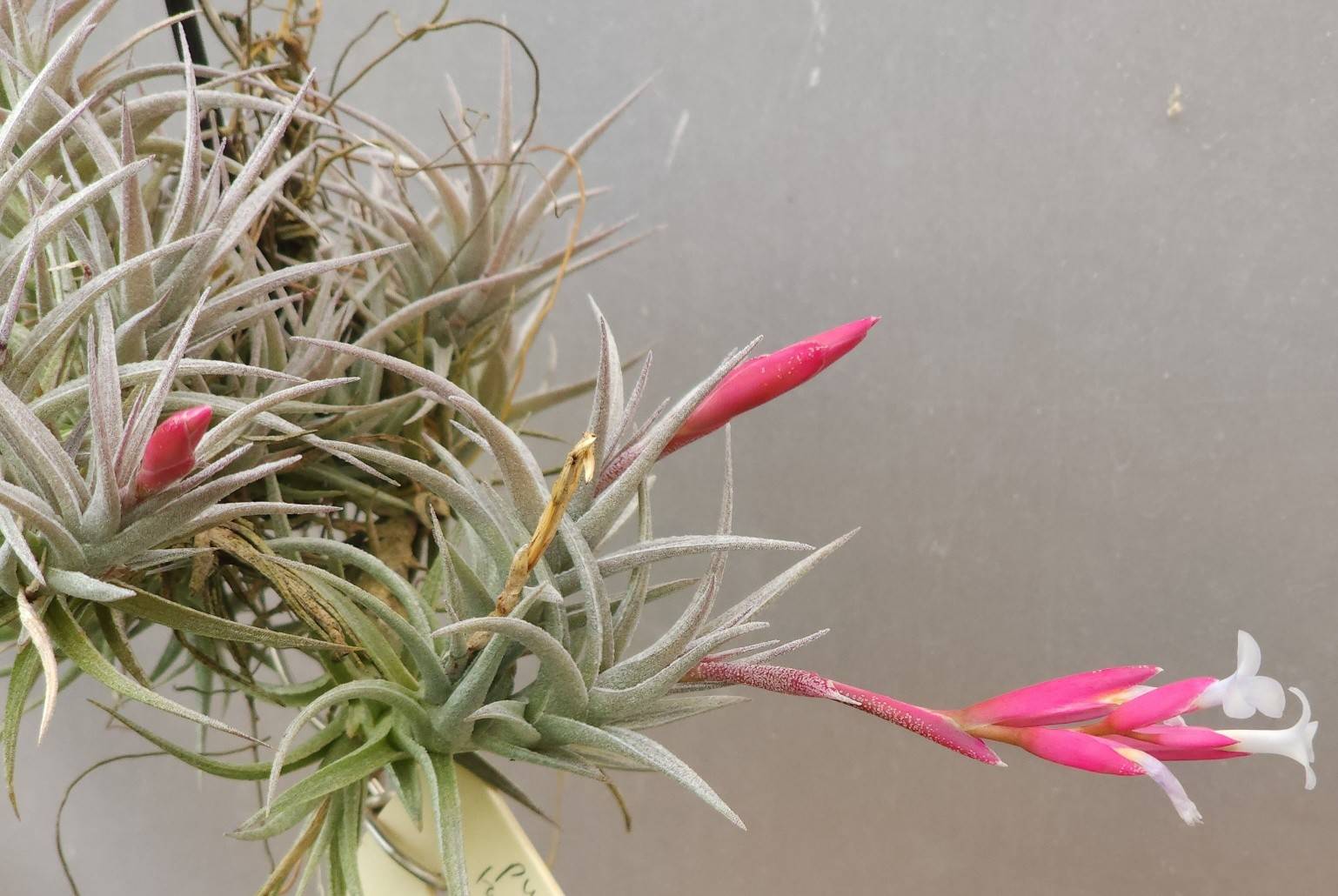
Plant growing on rocks attached by a dense root system, producing offsets and forming loose clumps, each plant with a stem, the bottom part sometimes much branched, up to 9 cm long, 4-6 cm in diameter, hanging, the top bent upwards.
Leaves numerous, spirostichous, internodes (distance between the leaves) ca. 1-3 mm, standing at an angle of 45-90° , 2.5-3.5 cm 1ong, whitish-grey white lepidote, very thick and succulent.
Sheath distinct from the blades, 5-8 mm long, 5-7 mm wide at the base, broad trapezoid, erect, covering and concealing the stem, whitish at the base, very thin and glabrous then getting leathery and grey lepidote on both sides.
Blade 2-3 cm long, 3 mm wide next to the sheath, triangular acuminate with a short linear tip, sometimes a little secund, canaliculate, the edges bent in, greenish-grey, both sides dense fine whitish grey adpressed lepidote, therefore looking almost whitish gray.
Inflorescence clearly exceeding the leaves, almost horizontal.
Peduncle slightly exceeding the leaves, 3-4 cm long, slender, almost horizontal or bent over, green, glabrous,
peduncle bracts few (up to 3), laxly imbricate, leaving the scape somewhat visible, 2 cm long, elliptic, acute, dark red dense lepidote.
Inflorescence (fertile part) exceeding the leaf rosette, simple, 2-3.5 cm long, 1.5-2 cm wide, lax, comprising 3-5, a little shifted (slightly spiral) arranged flowers, partly with a flowerless bract at the top, appearing almost distichous, the somewhat to clearly bent glabrous, round, light green axis clearly visible, internodes 5-6 mm long.
Floral bracts 1.5–1.7 cm 1ong, 8-9 mm wide, exceeding the sepals by a third and enclosing these bracts, oval, bristly acute, the upper ones acuminate, the tip a very little keeled, raspberry-red, membranous with hyaline edges, adaxial glabrous, nerved, abaxial the tip somewhat finely lepidote, the upper ones glabrous.
Flowers up to 3 cm long, the upper ones mostly getting smaller.
Sepals 1.1-1.3 cm long, 3.0-3.5 mm wide, lanceolate acute, pink, tip red, membranous, weakly nerved, the connate pair strongly keeled and by two thirds connate.
Petals 2.4-3.3 cm long, the blade 4 mm wide, roundish, tapering to 2 mm at the base, the tip bent outwards, light blue.
Stamens deeply enclosed, about one third as long as the petals, filaments 8 mm long, 0.9 mm wide, ribbon-like narrowing towards the top, once creased, white,
anthers 2-3 mm long, 0.3 mm wide, linear, fixed at the base, light yellow pollen lemon-yellow,
style to 8 mm long, 0.3-0.4 mm in diameter, white,
stigma upright, minutely small, not wider than the style, with very slightly spreading lobes, white,
ovary 2mm long, 1.5 mm wide, almost round, light green.
Etymology
The plant is named after its discoverer Andreas Hofacker.
Discussion
The plant belongs to the group of Tillandsia araujei Mez, but it differs in the following characteristics:
Plant much smaller and only short stemmed, leaves not densely but laxly arranged, shorter, very slightly secund, more succulent, not green but almost white fine lepidote.
Peduncle shorter, not upright but turned almost 90°.
Inflorescence (fertile part) composed of fewer flowers, arrangement not clearly spirostichous but lax, almost distichous, and laxly arranged flowers, the bent, glabrous, round, light
green axis clearly visible.
Petals light blue, not white.
Andreas Hofacker reports about his finding:
The south of Bahia is characterized by the Caatinga, a dry-bush forest with an extreme richness in species of fauna and flora. The word "Caatinga" is derived from the lndian language, meaning "bright, white forest". That type of vegetation is interspersed with the above-mentioned rocks. Nowadays the primary vegetation has been destroyed on a large-scale.
It has had to give way to the cultivation of citrus fruits, sugarcane and similar products.
On the Bambui-rocks and around them you often can find an interesting xerophytic vegetation. Numerous bromeliads (mostly of the genera Dyckia Schult. & Schult. fil, Encholirium Mart. ex Schult. & Schult. fil. and Bromelia L.) colonize the rocks. Miscellaneous species of cacti and other succulents are found there, too. At the locality of Tillandsia hofackeri are growing, amongst others: Arrojadoa rhodantha (Gurke) Britton & Rose, Brasilicereus phaeacanthus (Gurke) Backeberg, Cereus jamacaru DeCandolle , Coleocephalocereus goebelianus (Vaupel) Buining, Pilosocereus pachycladus F. Ritter, Tacinga inamoena (K. Schumann) N.P. Taylor & Stuppy, Tacinga saxatilis N.P. Taylor & Stuppy and Euphorbia attastoma Rizzini. Lithophytic Tillandsias are rarely found on the Bambui-rocks because these get extremely hot due to solar radiation. Tillandsia hofackeri grows on the less exposed sides of the rocks and thus has found a niche in which its survival is assured.
lntroduction
This attractive small plant was found by Andreas Hofacker, an excellent connoisseur of the Brazilian flora, on a trip in Brazil in the year 2000. These plants are from the south of Bahia, growing on Bambui-rock (carstic, dark grey or black precambrian limestone), that emerges from the Caatinga. Nearby there is a cement plant and the Bambui rocks are mined for cement production. The locality should be considered to be extremely endangered if not destroyed in the meantime. But there is hope that this new species can be found elsewhere because there are numerous mountains of similar appearance in the region.